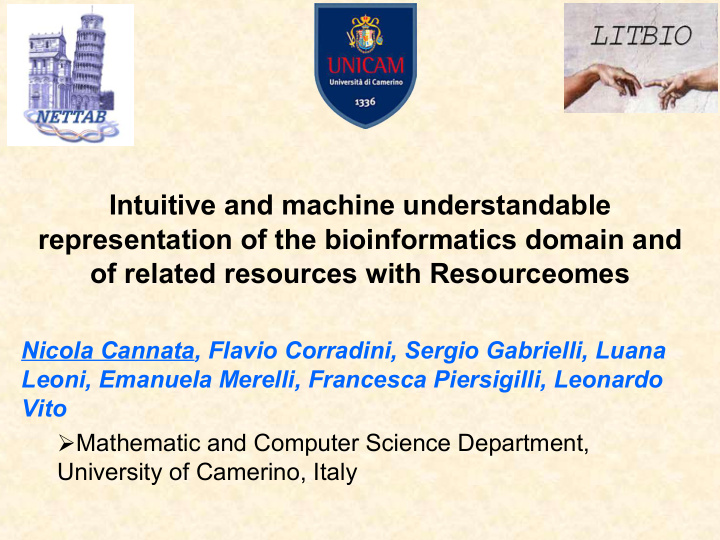



Intuitive and machine understandable representation of the bioinformatics domain and of related resources with Resourceomes Nicola Cannata, Flavio Corradini, Sergio Gabrielli, Luana Leoni, Emanuela Merelli, Francesca Piersigilli, Leonardo Vito Mathematic and Computer Science Department, University of Camerino, Italy
How many minutes (hours) do we spend every day in Google and bibliographic searches?
In life sciences and “-omics” disciplines we are becoming used to deluges and overflows…
The data overflow…
Besides data overflow we are experimenting also resources overflow. E.g. academic Articles ,…
Now science is becoming e-science…
Will e-science become g-science…?
Databases are essential resources for bioinformatics
Nucleic Acids Research (NAR) - Oxford Journals Database special issue Year Articles DB listed 2007 174 968 2006 164 858 2005 137 719 2004 142 548 2003 95 386 2002 94 335 2001 73 281 2000 95 226 1999 86 201
Web Servers are common tools for bioinformaticians
BMC Journal of PLoS Computational Briefings IEEE Trans. Applied Int.J.of Bioinf. Year Bioinformatics Computational Computational Biology in Comp. Biol. And Bioinformatics Res.& Appl. Bioinformatics Biology Biology and Chemistry Bioinformatics Bioinformatics (IJBRA) 2005 900 414 83 61 58 47 34 32 32 2004 627 209 69 53 40 22 24 2003 534 66 61 71 35 2002 365 40 52 77 41 2001 245 9 39 66 31 2000 178 1 52 72 33 Bioinformatics BMC Bioinformatics Journal of Computational Biology Computational Biology and Chemistry Briefings in Bioinformatics IEEE Trans. Comp. Biol. And Bioinformatics Applied Bioinformatics PLoS Computational Biology Int.J.of Bioinf. Res.& Appl. (IJBRA) 900 800 700 600 Articles 500 400 300 200 100 0 2005 2004 2003 2002 2001 2000 Year Articles published “ONLY” from main bioinformatics journals
Bioinformatics is evolving “IN SILICO EXPERIMENTS” From command line… (till 90s) To Web Services and workflows (now) to web interfaces and (perl) scripts… (with the advent of the WWW)
In this new bioinformatics Web Services play a key role. Programs interact with programs on the web…
Why to search for resources? - you have to develop a program, a database, possibly avoiding to re-invent the wheel… - interdisciplinarity… introduction to a new domain. Obtain a fast overview of a (new, for you) scientific domain (preferably in a visual fashion)
So, where to search for (bioinformatics) resources -that of course you are not aware of - ?
In search engines?… Good luck!
In specialized web sites? … First, find them!
In SIG web sites? … Are they updated?
In the literature? … When do you need them?
And also when articles are detected, maybe the presented resources are not there anymore!
In the age of WWW resources appear… and disappear
If you are lucky you can find some nice and intuitive reviews
What’s with the “staying updated”? -TOC e-mail services -Subject alert services
Resource directories are good place to start…
But the amount of resources and their variety require that directories would be machine understandable
Intelligent software agents will then be able to “reason” on the resources and to easily find them for you
Two “orthogonal” classifications - resources should be classified according their nature (a program, a database, a paper, a person…) and according what they refer to, what they are for
Computer science subjects can be classified…
As well as Mathematics subjects
But for Bioinformatics (and Life Sciences in general) is not existing any shared classification schema of the domain. And life scientists like taxonomies…
BioInformatics IsA IsA IsA IsA IsA IsA IsA IsA IsA Data And Databases Genetics SystemsBiology Structural Gene Sequence Genome Text And Population Phylogenetics Bioinformatics Expression Analysis Analysis Mining Ontologies Analysis The classification introduced for articles of “Oxford’s Bioinformatics” in 2005
Our proposal: Resourceomes Domain Ontology s n r e c n Concerns Concerns o C Resource Ontology A Resourceomes permits to arrange in an intuitive (for humans) and machine-understandable (for SW) manner the perceived structure of a domain and to “stick” resources (with their semantic relationships) to concepts of the domain
This is just our first prototype of resource ontology
Examples of semantic relationships between resources Cites Literature Resource resource Describes CollaboratesWith Literature Actor Artifact resource Publishes Creates
Better this representation…
… or this one?
A web-based semantic browser for Resourceomes
The first prototype of our browser
Passing with the mouse over the icons you can see a description and the URI of the resource
Many open issues: - Annotation of resources (manual, semi-automatic, automatic) - Representation of the domain (ontology, concept maps, topic maps, SKOS?) - Ranking of resources (page rank, judgments ) - Status of resources (agents checking them) - Graph visualization? (GRAPPA – Graphviz) - Not only browser but also visual editor (GrOWL?) -…
Acknowledgment www.litbio.org This work is supported by the Italian Investment Funds for Basic Research (FIRB) project “Laboratory of Interdisciplinary Technologies in Bioinformatics” (LITBIO).
Hoping that the bioinformatics community could soon say Thank you for your attention!
Recommend
More recommend